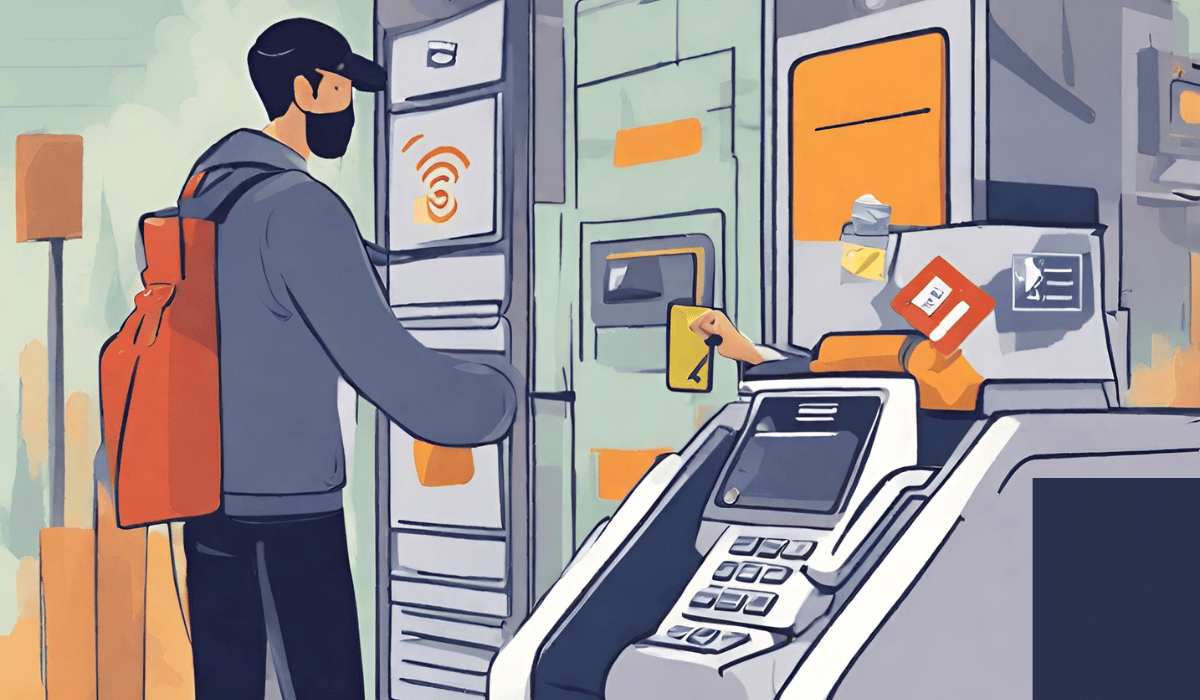The credit card security code (CVV or CVC) is not stored in the RFID data.
In today’s digital age, credit card security is of paramount importance. With the widespread use of RFID (Radio Frequency Identification) technology in credit cards, concerns about the safety of personal information have grown. One question frequently arises is whether the credit card security code is included in the RFID data. I will shed light on this and provide valuable insights into credit card security.
Understanding Credit Card Security Codes

What is a Credit Card Security Code?
A credit card security code, also known as CVV (Card Verification Value), CVV2, or CVC (Card Verification Code), is a three- or four-digit number providing an additional security layer for credit card transactions. It is usually found on the back of the card and is not displayed on the magnetic stripe or embossed on the card itself.
The purpose of the security code is to verify that the person making the online or telephone purchase has a physical card. This helps prevent unauthorized use of the card, as even if someone obtains the credit card number, they still need the security code to complete the transaction.
In addition to the security code, credit card companies also employ various other security measures to protect cardholders. These measures include encryption technology, fraud monitoring systems, and secure payment gateways. By combining these different layers of security, credit card companies aim to provide a safe and secure environment for online and offline transactions.
Importance of Credit Card Security Codes
Credit card security codes play a crucial role in keeping financial transactions secure. They act as a safeguard against fraudulent activities and provide additional protection for consumers. The merchant may request the security code to ensure the cardholder is the legitimate owner when purchasing.
Without the security code, unauthorized individuals could use stolen credit card information to make consumptions. However, it is important to note that while security codes enhance security, they are not foolproof and should be complemented by other security measures.
One such complementary security measure is the use of tokenization. Tokenization is a process where sensitive cardholder data, such as the credit card number and security code, is replaced with a unique identifier called a token. This token is then used for transactions, reducing the risk of exposing sensitive information. Tokenization enhances an extra layer of security by ensuring that even if the token is intercepted, it cannot be used to make unauthorized transactions.
Furthermore, credit card companies constantly invest in research and development to improve security measures. They collaborate with cybersecurity experts and stay updated on the latest threats and vulnerabilities. This proactive approach helps identify and mitigate potential risks, ensuring the safety of cardholders.
Consumers must remain vigilant and practice good security when using credit cards. This includes monitoring credit card statements for unauthorized transactions, using secure websites for online purchases, and keeping personal information confidential.
In conclusion, credit card security codes are essential to protect cardholders from fraudulent activities. They provide an additional layer of security and help ensure that the person making a transaction is the card’s legitimate owner. However, it is crucial to remember that security codes are just one part of a comprehensive security framework, and consumers should remain cautious and proactive in safeguarding their credit card information.
Introduction to RFID Technology
Radio Frequency Identification (RFID) technology is a world-shattering system that uses electromagnetic fields to identify and track objects mechanically. With its wide range of applications, RFID has become integral to various industries, from supply chain management to retail and healthcare.
Basics of RFID
At its core, RFID technology consists of two main components: the RFID tag and the RFID reader. The tag, also known as a transponder, is a small device that contains an antenna and a microchip. This tag is attached to the item or object that needs to be tracked or identified.
The RFID reader, however, is responsible for capturing the data stored on the RFID tag. It uses radio waves to attach to the tag, enabling the exchange of information. The reader emits a radio occurrence signal received by the tag’s antenna. The tag then responds by returning its unique documentation data to the reader.
RFID tags can be classified into two main types: passive and active. Inactive tags do not have a power source and rely on the energy emitted by the RFID reader. When the reader’s signal reaches the tag, it activates the tag’s microchip, allowing it to send its stored information back to the reader. On the other hand, active tags have their own power source, usually in the form of a battery. This enables them to transmit data over longer distances and have a wider range of functionality.
How Does RFID Work in Credit Cards?
RFID technology has revolutionized how we make payments, making contactless payment systems increasingly popular. In the context of credit cards, RFID technology enables quick and convenient transactions without needing physical contact with a payment terminal.
RFID-enabled credit cards, also known as “smart cards” or “contactless cards,” contain a tiny embedded RFID chip. This chip stores the necessary information for the transaction, including the credit card number, expiration date, and the cardholder’s name. When the card is brought near an RFID-enabled reader, the reader’s radio frequency signal activates the RFID chip in the card, allowing the information to be transmitted wirelessly.
With the tap or wave of the card, the RFID reader captures the data stored on the chip, and the transaction is initiated. This contactless payment method offers a convenient and efficient way to make purchases, reducing the need for physical contact and speeding up the checkout process.
It’s important to note that security actions, such as encryption and verification protocols, are implemented to protect the sensitive information stored on the RFID chip. These measures ensure that the data transmitted during the transaction is secure and cannot be easily intercepted or duplicated.
RFID technology in credit cards has transformed how we make payments, offering a seamless and efficient experience for consumers and businesses alike. As technology continues to advance, we can expect to see further developments in the field of RFID, opening up new possibilities and applications in various industries.
Is the Security Code Included in RFID Data?
How is Data Stored on RFID Chips?
Data storage on RFID chips varies depending on the implementation. Sometimes, the RFID chip may only store the credit card number and termination date, omitting the security code. This is done to balance convenience with security concerns, as transmitting the security code wirelessly could potentially expose it to unauthorized access.
However, it is important to note that not all RFID-enabled credit cards operate similarly. Some cards may indeed store the security code on the RFID chip, while others rely on the physical presence of the card for verification. Cardholders need to check with their credit card issuer to understand their RFID-enabled cards’ specific security features and capabilities.
Security Risks Associated with RFID Data

Although RFID technology offers convenience and efficiency, it poses certain security risks. One of the primary concerns is unauthorized scanning or skimming, where a malicious individual could retrieve the data from an RFID-enabled credit card without the cardholder’s knowledge.
However, it is crucial to highlight that the security code would not be vulnerable to skimming if not stored on the RFID chip. Nevertheless, it is still paramount to remain vigilant and practice responsible card usage to mitigate the risk of credit card fraud.
Protecting Your Credit Card Information

Common Methods of Credit Card Theft
Despite the evolving nature of credit card security, criminals continue to develop new methods to steal credit card information. Some common methods include phishing scams, card skimming devices, and hacking into online databases.
Phishing scams involve tricking individuals into providing their credit card details through fraudulent emails or websites. Card skimming devices are often hidden in ATMs or payment terminals, allowing criminals to capture credit card information when the cards are swiped.
Protecting yourself from credit card theft requires caution and awareness. Be vigilant when entering your credit card information online, and regularly monitor your bank statements for any suspicious activity. If you are suspicious your card has been compromised, contact your card issuer immediately.
Tips for Protecting Your Credit Card Security Code
While credit card security codes add an extra layer of protection, taking other precautions to safeguard your financial information is essential. Here are some tips:
- Memorize your security code and refrain from writing it or sharing it with others.
- Regularly update your contact information with your card issuer to ensure prompt communication in case of suspicious activity.
- Be cautious when providing credit card information online and only transact on secure websites.
- Consider using digital wallets or payment services that offer additional security measures.
- Monitor your credit reports and consider subscribing to credit monitoring services for early detection of any unauthorized activity.
The Future of Credit Card Security
Advances in RFID Technology and Security
As technology advances, so does the field of credit card security. RFID technology is constantly evolving, with new protocols and encryption methods developed to enhance security.
Efforts are underway to recover the security of RFID-enabled credit cards by implementing stronger encryption algorithms and authentication mechanisms. These advancements aim to make it more challenging for unauthorized individuals to intercept or replicate credit card information.
The Role of Biometrics in Credit Card Security
Another promising area in credit card security is the integration of biometric authentication. Biometrics, such as fingerprint or facial recognition, offer an exceptional and highly secure way to verify a person’s identity.
Credit card companies can add a layer of security by combining RFID technology with biometrics. For instance, a transaction may require both the physical presence of the card and biometric authentication, ensuring that only the genuine cardholder can complete the transaction.
While these advancements hold great potential, it is important to remain vigilant and adapt to changing security measures. Possession of the latest security protocols and best practices will help ensure the safety of your credit card information in the future.
5 Key Takeaways
- RFID technology is primarily designed for short-range communication and quick transactions.
- The CVV/CVC code is an anti-fraud measure not transmitted during RFID transactions.
- RFID chips generally contain only the card number and expiration date.
- To ensure security, always protect your card from unauthorized scanners.
- Regularly monitor transaction history to detect any unauthorized activity.
5 FAQs:
Q: What data is stored in the RFID chip of a credit card?
A: Primarily, the card number and expiration date.
Q: Can someone steal my CVV using an RFID scanner?
A: The CVV isn’t stored or transmitted in RFID transactions.
Q: How can I protect my card from RFID skimming?
A: Use RFID-blocking wallets or sleeves.
Q: Is using RFID technology safe for transactions?
A: Generally, yes, but it’s essential to be vigilant against unauthorized scanning.
Q: How often should I check my transaction history?
A: Regularly, preferably once a week, to ensure no unauthorized transactions.
Conclusion
In conclusion, credit card security codes protect cardholders’ financial information. While the inclusion of the security code in RFID data varies depending on the card issuer, it is critical to understand the security topographies of RFID-enabled credit cards and take appropriate measures to safeguard personal information. By staying informed and following best practices, you can confidently navigate the digital landscape and enjoy the convenience of contactless payments without compromising security.
